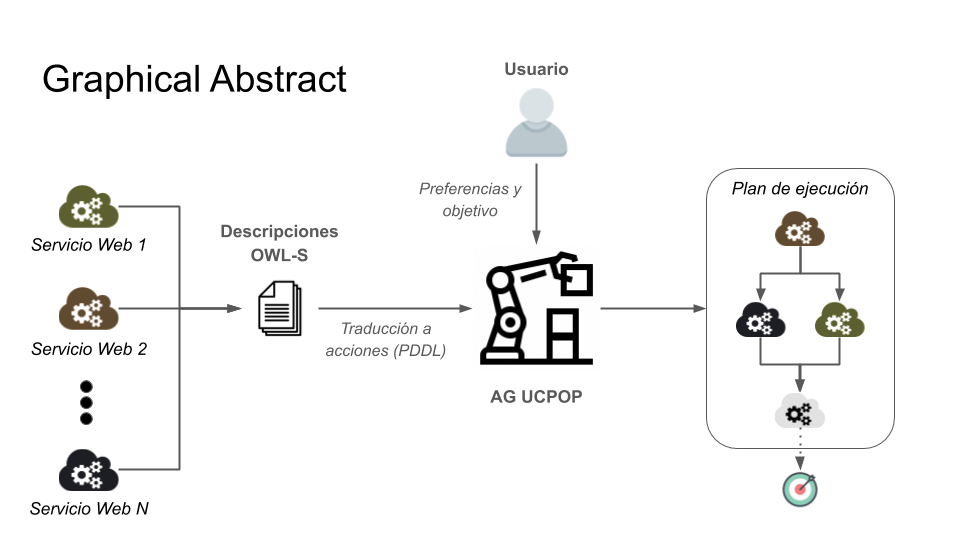Preference-based AI Planning for Web Service Composition
Keywords:
Web Service Composition, Partial Order Planning, Planning with Preferences, WSDL, OWL-SAbstract
A web service is a technology that allows data to be exchanged between applications using open protocols and standards. Web services generally offer basic functions that solve specific problems. The composition of services occurs when more complex problems need to be solved using successive invocations to other services. The automatic composition of web services is a current problem. Due to the continuous creation and updating of services, the manual composition of new services becomes impractical. Planning algorithms are an alternative to automate the process of web services composition. In particular, the planning algorithms with preferences allow users to guide the algorithm to find a solution in line with their requirements (eg. prioritizing the use of services according to properties such as availability, cost, response time, etc.). This paper introduces a Planning approach with preferences to compose and run complex services from a set of web services given as input. To evaluate the approach, different preferences about the input services were used to obtain the desired composition of services. As a result, it has been possible to measure the feasibility of the proposed approach and the impact of the use of preferences on the composition result.
Downloads
References
F. M. Mena, R. H. Ucan, V. U. Cetina and F. M Ramirez, “Web service composition using the bidirectional Dijkstra algorithm”. IEEE Latin America Transactions, 14(5), 2522-2528. 2016.
F. McCabe, D. Booth, C. Ferris, D. Orchard, M. Champion, E. Newcomer, H. Haas, “Web services architecture.” W3C note. 2004.
G. Rodríguez, A. Soria, M. Campo, “Artificial intelligence in service-oriented software design.” Engineering Applications of Artificial Intelligence, 53, 86-104. 2016.
E. Sirin, B. Parsia, D. Wu, J. Hendler, D. Nau, “HTN planning for web service composition using SHOP2.” Journal of Web Semantics, 1(4), 377-396. 2004.
S. D. Weld, “An introduction to least commitment planning.” AI magazine, 15(4), 27-27. 1994.
G. Rodríguez, L. Berdun, Á. Soria, A. Amandi, M. Campo. “Un enfoque inteligente para asistir en la planificación de proyectos ágiles”. In XV Argentine Symposium on Artificial Intelligence (ASAI). 2014.
A. Monteserin, L. Berdún, A. Amandi. “Analysing the PDDL language for argumentation-based negotiation planning”. In International Conference on Computational Science and Its Applications (pp. 698-713). Springer, Berlin, Heidelberg. 2012.
L. Berdun, A. Amandi, M. Campo, “An agent specific planning algorithm.” Expert Systems with Applications, 39(5), 4860-4873. 2012.
S. Chattopadhyay, A. Banerjee. “Qos constrained large scale web service composition using abstraction refinement”. IEEE Transactions on Services Computing. 2017.
F. Chen, R. Dou, M. Li, H. Wu. “A flexible QoS-aware Web service composition method by multi-objective optimization in cloud manufacturing”. Computers & Industrial Engineering, 99, 423-431. 2016.
M. Cremene, M. Suciu, D. Pallez, D. Dumitrescu. “Comparative analysis of multi-objective evolutionary algorithms for QoS-aware web service composition”. Applied Soft Computing, 39, 124-139. 2016.
A. S. da Silva, H. Ma, M. Zhang. “Genetic programming for QoS-aware web service composition and selection”. Soft Computing, 20(10), 3851-3867. 2016.
Z. Wang, B. Cheng, W. Zhang, and J. Chen, “Q-Graphplan: QoS-Aware Automatic Service Composition with the Extended Planeación Graph.” IEEE Access, 8, 8314-8323. 2020.
L. Purohit, S. S. Chouhan, and A. Jain, “Dynamic Web Service Composition Using AI Planning Technique: Case Study on Blackbox Planner.” In Social Networking and Computational Intelligence (pp. 183-195). Springer, Singapore. 2020.
N. Lin, U. Kuter, E. Sirin, “Web service composition with user preferences.” In European Semantic Web Conference (pp. 629-643). Springer, Berlin, Heidelberg. 2008.
Y. Zhao, S. Wang, Y. Zou, J. Ng, T. Ng. “Automatically learning user preferences for personalized service composition”. In 2017 IEEE International Conference on Web Services (ICWS) (pp. 776-783). 2017.
H. Wang, P. Ma, Q. Yu, D. Yang, J. Li, H. Fei. “Combining quantitative constraints with qualitative preferences for effective non-functional properties-aware service composition”. Journal of Parallel and Distributed Computing, 100, 71-84. 2017.
D. Weld, J. Penberthy. “UCPOP: A sound, complete, partial order planner for ADL”. In International Conference on Principles of Knowledge Representation and Reasoning (pp. 103-114). 1992.
V. Portchelvi, V. P. Venkatesan, G. Shanmugasundaram, “Achieving web services composition: a survey.” Softw Eng, 2(5), 195-202. 2012.
D. Fensel, C. Bussler, C. “The web service modeling framework WSMF.” Electronic Commerce Research and Applications, 1(2), 113-137. 2002.
D. Martin, M. Paolucci, S. McIlraith, M. Burstein, D. McDermott, D. McGuinness, N. Srinivasan, “Bringing semantics to web services: The OWL-S approach.” In International Workshop on Semantic Web Services and Web Process Composition (pp. 26-42). Springer, 2004.


